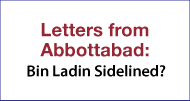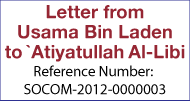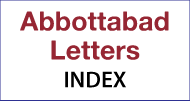ABBOTTABAD DOCUMENTS RESEARCH STRATEGY
In early November 2017, the CIA released a massive trove of electronic materials captured during the 2 May 2011 raid on Usama bin Laden’s compound in Abbottabad, Pakistan. These materials were stored on 183 DVD recordable media devices recovered during the mission. The materials contained therein, consist of every type of electronic file including videos, images, audio, music, movies, games, executables, websites, documents, spreadsheets, presentations, temporary files, and even inadvertent computer viruses. The thematic content of these materials includes entertainment, news reporting of politics and economics, revolutionary warfare theory, religious research and fatwas, Jihadi propaganda, al-Qaeda public statements, possible targeting information, instructions for making explosives and electronic detonators, and media reflections on major terrorist attacks.
Most interesting is the personal correspondence between al-Qaeda Senior Leadership, messages to al-Qaeda and affiliated commanders in the field, and directives issued to the al-Qaeda rank and file members. The total of data recovered from the 183 DVDs contains over 467,501 individual files, comprising nearly a third of a Terabyte (306 Gigabytes) of data in volume. Further complicating matters is that most files are written or recorded in the Arabic language, and many files are duplicates, have improper text encoding, or even corrupted to the point of being unreadable. The lack of complete useable files from the Abbottabad compound poses a complication in gaining a complete understanding of the content and this accounts for the lack of academic and media research into this trove of material. To date, only National Geographic channel has done any substantial analysis of these difficult-to-impossible data files.
The purpose of the Tribal Analysis Center’s research effort is to find and evaluate any information contained within the seized materials which may be of interest in debunking the mythical reverence growing about Usama bin Laden and other senior al-Qaeda leadership personalities. A secondary purpose involves organizing the most accessible material into file groups from the collection of files converted to PDF and develop a two-pronged inductive and deductive research strategy to most efficiently and effectively discover, translate, interpret, and assess the most relevant and useful documents. Once completed, these broad studies will be very useful to other researchers.
Tribal Analysis Center
Watch ‘Bin Laden’s Hard Drive’
on the National Geographic Channel





